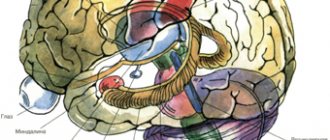Semantic aphasia is a complex speech pathology associated with impaired comprehension of logical-grammatical structures. Occurs when the parieto-temporo-occipital region (TPO zone) of the left hemisphere is damaged.
With this type of aphasia, a person experiences difficulties understanding the semantics of linguistic units, especially in the context of complex grammatical structures, suffers from a disorder of visual and spatial thinking, acalculia and elements of apraxia.
A syndrome characterized by a gradual loss of the ability to speak, read, write, and understand what others say is classified as primary progressive or semantic aphasia.
What is semantic aphasia
People with semantic aphasia have great difficulty understanding the meaning of words, finding names, or naming living and nonliving objects. Over time, people with semantic aphasia begin to use more general names for specific things.
For example, they may say “animal” instead of “dog.” As their understanding of words deteriorates, they may eventually become unable to understand the speech of others.
Semantic aphasia as a separate type of aphasia was first described by the English aphasiologist Henry Head. He proposed a psycholinguistic classification of aphasias.
Subsequently, the scientist’s neuropsychological concept was developed by other researchers, including being reflected in the works of the Soviet psycholinguist A. R. Luria, who gave a more detailed description of this pathology.
It represents a cognitive disorder: there is no understanding of the semantics of the lexeme in the context of logical-grammatical language constructions.
Causes
- acute disorders of the blood supply to the brain (hemorrhagic stroke, ischemic stroke, subarachnoid hemorrhage, etc.);
- cancerous tumors of the brain and other organs that metastasize to the brain;
- TBI; damage to the cerebral cortex during neurosurgery;
- diseases of the brain (meningitis, meningoencephalitis), as well as brain abscesses of various etiologies (syphilis, tuberculosis, viral, bacterial, fungal infections);
- neurological diseases of a degenerative nature (for example, Parkinson's disease).
Pathogenesis
The above factors cause damage to certain areas of the brain (21st, 37th, 39th, 40th, 52nd Brodmann fields), which are included in the block of perceptual communication processes: acceptance, comprehension and storage of surface information. These fields combine multimodal information.
With semantic aphasia, the understanding of the basic, primary meaning of a word, associated with its sound shell, remains unchanged. Violations are present in the perception of secondary, figurative or homonymous meaning, the semantics of a word in the context of a phrase or sentence.
Problems arise with the perception of addressed speech, a violation of spatial perception, constructive apraxia, amnesia, which consists in difficulties in selecting the lexemes necessary for the statement.
Symptoms of the disorder, staging
Semantic aphasia occurs when there is damage to the area at the junction of the occipital, parietal and temporal lobes. But does this mean that the only symptom of such a lesion will be speech perception disorder? No, this is far from true. There cannot be an isolated violation. To one degree or another, all three described structures suffer. Some are definitely more so. Accordingly, the symptoms almost always vary in intensity and nature. The average clinical picture can be presented as follows:
- A typical and main feature of the pathological process is the inability to understand complex speech addressed to the patient. At the same time, the analysis of phrases and comprehension of the simplest constructions are preserved, not counting the rare and most severe cases. Complex structures cause misunderstanding and confusion.
- A violation of the understanding of the relationship between words in a sentence is detected. Species-temporal, logical, functional relationships, spatial relationships and other options. A person does not understand metaphors, phraseological units and perceives any expression in the literal sense. The creative component of the speech, verbal component of thinking is lost.
- Disorganization of the perception of specific language constructions is revealed. Cases, genders, numbers, parts of speech. Nouns are replaced by adjectives and verbs.
With all that has been said, not only perception is disrupted, but also one’s own reproduction of speech structures. Expressive speech with semantic aphasia is almost impossible; it becomes poor, meager, inexpressive in meaning and form. With the formal preservation of intelligence, a person is not able to express his own thoughts and understand the thoughts of other people.
Additionally, symptoms of neurological deficit occur when the lobes of the brain are damaged:
- visual agnosia - the patient is unable to perceive the relationship of visible objects, especially in spatial terms,
- loss of the ability to perform mathematical operations, including simple ones, in the most complex clinical cases (de facto, during rehabilitation of such patients it is necessary to relearn mathematics again),
- disturbance of orientation in one’s own body (in simple cases this is a vague unpleasant sensation, in the most complex cases it is a complete inability to perceive one’s own body as a single whole, to navigate its segments; a person may declare that he does not have a hand or that the hand does not belong to him),
- inability to recognize objects by touch with eyes closed.
In some cases there is an amnestic component. The patient not only does not understand the complex speech addressed, does not understand logical and cause-and-effect relationships, but is also unable to remember the names of objects, describes them in general terms (a plate is such utensils, etc.), in a functional context (a spoon is what one eats, bus - what they ride on, etc.).
Due to the inability to understand complex speech, the patient has to work with extreme caution, carefully checking the words. This requires remarkable professionalism from a practicing speech therapist and neurologist, patience and a systematic, comprehensive approach. Therefore, the key recommendation to the patient’s relatives is to carefully choose doctors; not everyone can cope with such a problem efficiently. Skills and qualifications required.
Signs also significantly depend on the severity of the pathological process. Semantic aphasia is staged according to clinical severity into three stages:
- The first degree is accompanied by minimal changes. The speech defect and perception impairment are weak and practically do not interfere with communication.
- Moderate degree. The clinic is pronounced. There are massive disturbances in normal speaking and speech perception. There are no other manifestations or they are weak.
- Severe or severe semantic aphasia. A total disturbance of perception and speech reproduction is complemented by other neurological deficits. It is considered the most unfavorable in terms of recovery.
Classification
Semantic aphasia has three stages:
- Easy. The consistent connection between phenomena is disrupted, and errors occur in distinguishing cause and effect. Difficulties arise in the contextual selection of a particular word and the interpretation of complex speech structures. There are difficulties in solving logic problems.
- Medium-heavy. There are difficulties in understanding grammatical constructions and allegorical phrases, and in performing arithmetic operations.
- Heavy. Characterized by pronounced disorders of visual-spatial perception. Understanding grammatical phrases and prepositional structures is significantly difficult or inaccessible.
Since this disorder primarily affects the temporal lobe of the brain, this process can be called irreversible.
Most often, semantic aphasia is observed in people aged 50-60 years and can last for 12 years. Although these figures are approximate and may deviate in one direction or another.
Often, in addition to speech disorders, behavioral deviations appear. Unfortunately, there are no medications to cure this condition yet. There are medications that can improve the condition and help retain certain moments from life in memory. However, no one can give a more favorable prognosis.
Research has shown that exercise helps improve brain health and improves mood and overall fitness. Eating a balanced diet, getting enough sleep and limiting alcohol consumption are other important ways to promote good brain health.
Other diseases that affect the brain, such as diabetes, high blood pressure and high cholesterol, should also be treated if present.
Therapy and recovery
Methods for eliminating semantic aphasia are selected by a neurologist in tandem with a speech therapist and a number of other specialists, if necessary. An important point in treatment is eliminating the cause of the disease. This is done through medication or surgery, with the addition of physiotherapy and traditional medicine. The fight against the speech disorder itself is carried out with the help of medications and speech therapy sessions. In case of brain damage, nootropics, neuroprotectors, vitamins and mineral complexes, and vasodilators are used. The work of a speech therapist involves practicing speech, counting, writing, reading, and improving spatial orientation. To obtain the maximum effect, the victim is advised to exercise at home with loved ones.
The work of a speech therapist involves practicing speech, counting, writing, reading, and improving spatial orientation.
The prognosis for recovery in semantic aphasia depends on the quality of the treatment provided, the patient’s focus on results, and his age. If therapy is started in a timely manner and the patient follows all the doctor’s recommendations, the chances of returning lost functions are high. Modern approaches can relieve speech disorders caused by such dangerous conditions as stroke, tumors, and degenerative brain diseases.
When to sound the alarm?
It is necessary to sound the alarm and conduct a thorough diagnostic examination when observing the following three indicators if:
There is a gradual deterioration of language (not just speech). The language problem is initially the only deficiency. The main cause is a neurodegenerative disease.
A distinctive feature of the semantic variant of aphasia is the progressive loss of word meanings. If there are additional severe problems in identifying objects or persons, the condition is also called semantic dementia.
Other language skills, including the ability to produce speech and repeat phrases and sentences spoken by others, are not affected. However, although the affected person may continue to speak freely, their speech becomes unclear and difficult to understand because many words are omitted or replaced.
Language problems increase over time. There is a slow but progressive loss of vocabulary and the ability to understand what people say. Speech becomes increasingly vague and the amount of speech tends to decrease.
In the future, non-linguistic functions are disrupted during the disease. In particular, a person may find it increasingly difficult to recognize familiar people or household objects. Problems associated with carrying out normal daily activities are also increasing.
How to recognize?
By a number of signs you can find out that a person is beginning or progressing in the form of aphasia we are considering.
Anomie
Inability to remember the names of objects; the difficulty of “finding the right word”.” The affected person may not be able to name the picture of the truck or may substitute another word in the same category, such as “car” instead of “truck.”
Abbreviated understanding of one word
The affected person cannot remember what words mean, especially words that are less familiar or used less frequently. For example, he might ask “What is a truck?”
When the patient is asked to bring an orange, he may return with an apple because the meaning of the word “orange” has been lost. This does not mean that the object is not recognized, as evidenced by the fact that the patient will not attempt to eat an orange without peeling it.
Forgetting familiar objects
Inability to remember what a familiar object is or how it is used. For example, the victim may be unable to identify common kitchen utensils and how they are used in food preparation. This is very unusual in the initial stages of semantic aphasia, but may appear later.
Surface dyslexia/dysgraphia
Difficulty reading and writing words that do not follow the rules of pronunciation or spelling; such words are written or pronounced “as if” they were following rules.
Dyslexic speech disorders
Symptoms and manifestations
Amnestic aphasia is characterized by a mild course of the disease and a blurred manifestation of the clinical manifestations of the disease. Among the most common manifestations are the following symptoms:
- Slow speech of the victim, with pronounced intervals between sentences, or vice versa, the victim’s speech becomes fluent, illogical, turning into “porridge”;
- Repeated repetition of the same words or phrases;
- The presence of paraphrases is a descriptive characteristic of the semantic load of a word. Speech becomes descriptive;
- The patient misses words, most often nouns;
- Also, the patient cannot remember the name of the item or object in question, but knows its function and appearance.
Despite this, the patient's reading and writing skills do not suffer. His speech is constructed correctly, both grammatically and logically. The patient does not have difficulties with the acoustic pronunciation of words, as well as articulation. The patient's speech becomes expressive and replete with a large number of verbs.
It is important to note that the patient easily remembers the name of an object when prompted or in context, for example, if you name the first syllable of the desired word, the patient will easily remember its ending.
Symptoms of semantic aphasia
- Phrasal speech is expressive, normal in volume and speed, but consists of simple sentences.
- Characteristic are grammatical errors regarding the agreement of words and the use of the desired case form. A person understands the meaning of simple syntactic structures and individual words. Common or complex sentences are difficult to understand.
- It is difficult to perceive isolated phrases, inserted structures, complex and compound sentences.
- Sayings, proverbs, metaphors, phraseological units and other set expressions are perceived not in a figurative, but in a literal meaning (for example, what goes around comes around; they count chickens in the fall; happy people don’t watch the clock; sit in a puddle, put spokes in the wheels, make molehills).
- The understanding of the part-speech division of linguistic units is impaired. Noun names patients classify running, dawn, and departure as verbs, and the verbs turn green and blush as adjectives; adjectives that become nouns (canteen, ice cream, bakery) are considered adjectives.
- Due to a violation of understanding the grammatical category of a word, the patient cannot understand and fulfill requests of this type: touch his head with a ruler, show a glass with a pencil.
- The understanding of prepositional-case constructions is impaired due to spatial agnosia (under the table, above the head, on the table, in the nightstand), forms of comparison (faster, slower; more, higher, lower), word forms of R.p. (mother’s coat, friend’s car), revolutions with a temporary value (after spring, on the eve of a holiday).
- The perception of time and space is disrupted. A person cannot fulfill a simple request: to arrange objects in a certain way (for example, put a pencil on the right side of the eraser and to the left of the book; put a notebook in the middle of the table).
- Calculation develops due to difficulties in performing sequential arithmetic operations. There are problems understanding ordinal numbers.
- There are violations in the lexico-grammatical development of the statement. The patient also forgets the names of some objects when creating a sentence. In such cases, the use of descriptive phrases is often observed (what they write with; what they drink from), or words with categorical meaning (this is such a fruit, such furniture), the building of associative connections can be traced as a way of replacing the main word (yellow, shines in the sky )
- Written speech, just like oral speech, contains only uncomplicated syntactic structures, and manifestations of agraphia can be observed.
- The ability to read and understand what is read is preserved, but only simple texts written without the use of complex, long sentences are available for full perception and comprehension. Reading fiction is most often not conscious.
Semantic aphasia. Examination and rehabilitation of patients
Cerebrovascular accident affecting the dominant hemisphere often leads to long-term impairment of cognitive and sensorimotor functions. In this case, it is practically important to answer the question: will the impaired functions be restored? However, in most cases, failure to recover during the first weeks or months after stroke carries a negative prognosis for subsequent recovery [10, 15]. However, in recent years, an increasing number of observations have been accumulating indicating the continuation of the recovery process years after a stroke. Given these data, there is a growing need to develop new methods for restoring speech and determining the long-term prognosis for patients who have suffered a stroke [4, 14]. The mechanisms involved in speech restoration in the acute period of stroke and in the long-term period are different. In the first days after the disaster, the recovery effect is due to the results of reperfusion therapy and restoration of neuronal function in the ischemic penumbra zone [5, 7]. The recovery process at later stages includes processes of compensation, based on the inclusion of additional areas of the brain, and reorganization (displacement of activity from the primary speech areas). This restorative potential of the brain is known as “neuroplasticity” [1, 8, 9]. Neuroplasticity is believed to be the basis of learning in both healthy and damaged brains. Moreover, under pathological conditions, the effectiveness of neuroplasticity processes depends on the degree of damage to those neural structures that may be involved in the recovery process. A recent meta-analysis of studies using functional magnetic resonance imaging (MRI) showed that when patients recover speech disorders, the process involves the remaining primary speech areas and new cortical areas of the left hemisphere, as well as areas of the right hemisphere homologous to the speech areas of the left . It has been found that in patients with aphasia, different areas of the cerebral cortex are activated and, therefore, different compensatory mechanisms are activated. Regional differences in the involvement and suppression of the activity of individual zones, as well as the degree of lateralization of brain activity, have been identified, which determines differences in recovery mechanisms depending on the location of the lesion [6, 12, 13, 16]. These data highlight the relevance of developing new approaches to improving diagnosis and restoring speech functions in patients with post-stroke aphasia.
Among the patients with the consequences of acute cerebrovascular accident and speech disorders who were treated in the neurological department of the State Budgetary Institution of Healthcare of the Moscow Region MONIKI named after. M.F. Vladimirsky, in some cases, during a speech therapy examination, the dominance of impressive speech disorders over expressive ones was revealed. These forms of aphasia are caused by the localization of the brain lesion in the posterior parts of the left hemisphere. At the same time, semantic aphasia occurs quite often, is distinguished by the severity of speech disorders and, unfortunately, by the low results of speech therapy correction [1, 3, 6]. The reasons for the low recovery results in posterior forms of aphasia are the lack of systematized recovery methods that take into account the structure of the cognitive defect, based on the results of modern research, and the lack of interaction between specialists (speech therapists and neurologists) involved in the rehabilitation of such patients.
If acoustic-gnostic (sensory) aphasia, which occurs with damage to the mid-posterior parts of the temporal region of the left hemisphere, and acoustic-mnestic aphasia, associated with suffering in the posterior third of the superior temporal gyrus and a primary decrease in the volume of auditory-verbal memory, are well known to neurologists, then semantic aphasia, which occurs with lesions in the parieto-temporo-occipital region are less easily diagnosed and fall out of sight of the neurologist.
Semantic aphasia is a component of the TPO syndrome (temporo-parieto-occipital syndrome), which occurs when the junction of the listed lobes of the left hemisphere of the brain is damaged. Here are located the tertiary fields of the second functional block (the block for receiving, processing and storing exteroceptive information according to A.R. Luria), which perform simultaneous (simultaneous) analysis and synthesis of multimodal information. Damage to the TPO zone manifests itself in disturbances in orientation in external space (especially right-left orientation), defects in the spatial orientation of movements and visual-spatial actions (constructive apraxia). Violation of the structural preconditions of thinking determines the uniqueness of the picture of speech disorders.
Clinical manifestations of semantic aphasia consist of impressive agrammatism (difficulty in understanding logical-grammatical phrases) and violations of semantics (understanding the deep meaning of a word). Speech disturbances are complemented by other manifestations of TPO syndrome: simultaneous agnosia (inability to understand the plot of a drawing or to compose a coherent plot from individual drawings), constructive apraxia (inability to form a whole from parts), spatial apraxia (impaired orientation in space), acalculia, which can be expressed as difficulty reading complex numbers and mathematical symbols, and the inability to perform counting operations.
Gradations of severity of semantic aphasia are determined conditionally and are associated with the severity of impressive agrammatism. It is believed that this syndrome can occur only in moderate and mild degrees of severity [2, 3]. However, we observed patients in whom this syndrome occurred in a severe degree of severity, which was expressed in a violation of visual object gnosis, a gross violation of visual-spatial perception, acalculia, apractagnosia, and inability to understand the simplest prepositional case constructions.
We present a clinical case of a patient with severe semantic aphasia and rehabilitation methods used in the neurological department of the State Budgetary Institution of Healthcare of the Moscow Region "MONIKI named after. M.F. Vladimirsky."
Patient P. suffered an ischemic stroke in the territory of the left middle cerebral artery, as a result of which he developed right-sided hemiparesis with a decrease in strength to 3 points in the muscles of the arm and 4 in the legs and speech disorders. MRI of the brain revealed massive damage to the junction of the occipital, parietal and temporal lobes of the left hemisphere (Fig. 1).
The syndrome manifested itself in the following aspects: impaired visual perception; impairment of visual-spatial perception (Fig. 2); difficulties when performing counting operations (Fig. 3); difficulties in time orientation (Fig. 4) and inaccessibility to understanding prepositional-case constructions.
A violation of right-left orientation was detected when asked to identify the corresponding part of the body in the picture (Fig. 5).
To confirm the connection between a pronounced impairment of visual-spatial perception and the disintegration of the meaning of a word, the patient was shown a text written in a vertical direction with the aim of translating it into a horizontal direction. This task caused great difficulty for the patient (Fig. 6).
At the same time, he had no changes in auditory speech gnosis, there was no narrowing of the volume of auditory-speech memory (memorization of up to 6 words and their subsequent delayed reproduction was possible), motor difficulties were noted.
Rehabilitation work with the patient was carried out taking into account the severity of the syndrome. Therefore, at this stage, a bypass recovery path was used, which consisted of attracting the preserved capabilities of the subdominant hemisphere and preparing for stimulation of the depressed dominant hemisphere.
The restoration technique was divided into three stages. At the first stage, visual gnosis was corrected. Difficulties in naming objects were overcome using the following methodological techniques: differentiation of object pictures (Fig. 7), perception of stylized images and correlation of unfinished objects with the model.
At the second stage, work was carried out to restore the understanding of mathematical signs and simple mathematical operations using techniques for differentiating numbers and solving mathematical problems by comparing them (Fig. 8). At the third stage, the central task of rehabilitation was the restoration of spatial perception. The patient was offered the following methodological techniques: analysis of the body diagram in the picture with transfer to himself, showing object pictures, working with objects in the room. In order to prepare for the restoration of speech semantics with an average severity of the syndrome at this stage of rehabilitation, the patient was offered a text written in a vertical direction to be translated into a horizontal direction.
As a result, during a two-week course of rehabilitation work, it was possible to overcome the severe degree of severity and achieve a clinical picture of moderate severity in the patient. It was expressed in typical speech errors: mild visual-spatial difficulties, as well as when performing complex counting operations, difficulties in understanding logical-grammatical phrases and difficulties in understanding the figurative meaning of a word.
Thus, despite the relatively short period of training, 2/3 of the patients achieved good results. The key to achieving such recovery results was an integrated approach to the rehabilitation of patients with the consequences of a stroke.
Diagnostics
To diagnose the disease, various methods are used, including: magnetic resonance imaging, computed tomography, cerebral hemodynamics study, cerebrospinal fluid analysis, transcranial Doppler ultrasound (USD), duplex scanning. Anamnesis data is analyzed (presence of head injury, tumors, stroke, etc.).
Consultation with a neurologist and speech therapist is required.
In cases where semantic aphasia is not clearly expressed, the determination of speech disorders is possible only by performing specially selected tasks and exercises aimed at identifying certain disorders.
When making a diagnosis, it is important to differentiate semantic aphasia from other speech disorders. Unlike dysarthria, articulatory ability is preserved. Semantic aphasia differs from acoustic types of aphasia in the preservation of phonemic hearing and auditory-verbal memory. With dynamic aphasia, speech becomes non-expressive, stereotypical statements are observed, which does not happen with semantic aphasia.
Varieties and connections with other types of disorders
The division of semantic aphasia into specific types is arbitrary. In most cases, the pathology is represented by mild or moderate symptoms.
Officially, there are three types of semantic aphasia based on severity:
- mild – poor understanding of cause-and-effect relationships. It is difficult for the patient to select synonyms and antonyms for words, and to correctly evaluate complex semantic phrases. Solving logical problems is difficult for him;
- moderate – the main problems are expressed more clearly, the figurative meaning of words and phrases is unclear. Problems arise with counting and solving mathematical problems;
- severe – all the symptoms of the pathology are present. They are expressed to such an extent that it leads to a significant decrease in the quality of life.
Semantic aphasia rarely becomes an isolated manifestation of brain damage. It is rarely rude; it is usually identified during examination of the patient in connection with suspicion of other types of speech disorders.
Treatment of semantic aphasia
Drug therapy with nootropic and vasoactive drugs should be carried out simultaneously with speech therapy correction and rehabilitation measures.
Rehabilitation work is carried out by a neurologist, speech therapist, and neuropsychologist. Treatment must be comprehensive.
Speech therapy correction includes:
- restoration of visual-spatial thinking (the patient is offered various exercises: completing a figure or missing parts of the picture, assembling a puzzle, arranging objects in accordance with the task);
- restoration of semantic perception (analysis of grammatical word forms, cognates, polysemantic words and homonyms and their use, differentiation of participial and participial phrases, selection of synonyms and antonyms, interpretation of set expressions and metaphors is carried out);
- restoration of arithmetic abilities (with the easy form, logical problems are solved (for example: Kolya is taller than Petya, but shorter than Vasya. Which of the boys is taller than all? Below all?); with the medium form, the stages of solving complex mathematical expressions are analyzed; with the severe form, they achieve the ability to solve elementary examples of addition and subtraction).
Symptoms
According to A.R. Luria, a distinctive feature of amnestic-semantic aphasia is the collapse not of all speech semantics, but only of some categories. In this case, the violations do not affect the intelligence of patients. Misunderstandings of instructions and the speech of others are associated with a problem in the analysis and synthesis of grammatical categories if a person has several words and tasks.
For example, patients correctly place objects to the left and right of each other according to instructions. But if you ask them to locate the fork and place it to the right of the plate and at the same time to the left of the glass, the patient will become confused. The problem is that when carrying out complex instructions, a person needs to imagine several phenomena and categories at once, but his brain cannot cope with such work.
Patients with semantic aphasia can speak competently in simple sentences; expressive speech is not impaired. Reading and writing skills remain normal, but difficulties may arise when perceiving sentences complicated by participial and participial phrases. If you talk with the patient slowly, using only simple units from a syntax point of view, you can achieve complete understanding.
Thus, among the main symptoms of semantic aphasia, the following signs of the disease can be distinguished:
- Memory loss.
- Narrowing your horizons.
- Primary apraxia is the inability to perform sequential movements to achieve a goal. Patients with semantic aphasia cannot assemble puzzles or repeat drawings following oral instructions.
- Spatial confusion.
- Disturbances in the perception of relationships between objects and space.
- Simultaneous agnosia is the inability to keep several objects in sight at the same time.
- Body schema disorders.
- Acalculia is a violation of counting.
- Agrammatism in one's own speech.
- Misunderstanding of grammatical constructions that contain prepositions to indicate spatial or temporal relationships (on, above, under, before, where, where).
- Difficulty understanding sentences with inversion.
- Difficulties in answering such questions: “Olya is older than Katya. Valya is younger than Olya and Katya. Who is the oldest? The solution of such problems is hampered by violations of the logical system.
- If words that are logically connected are separated from each other in a sentence, a patient with aphasia will not understand it. For example, many customers came to the store where the fish were brought.
- Sentences with adverbs above, below and words on - CA, which denote container, storage, are also perceived with great difficulty.
A person with semantic aphasia perceives a word only as a direct carrier of information, without taking into account its grammatical changes, logical stresses in a sentence and other lexical environment of the linguistic unit.









